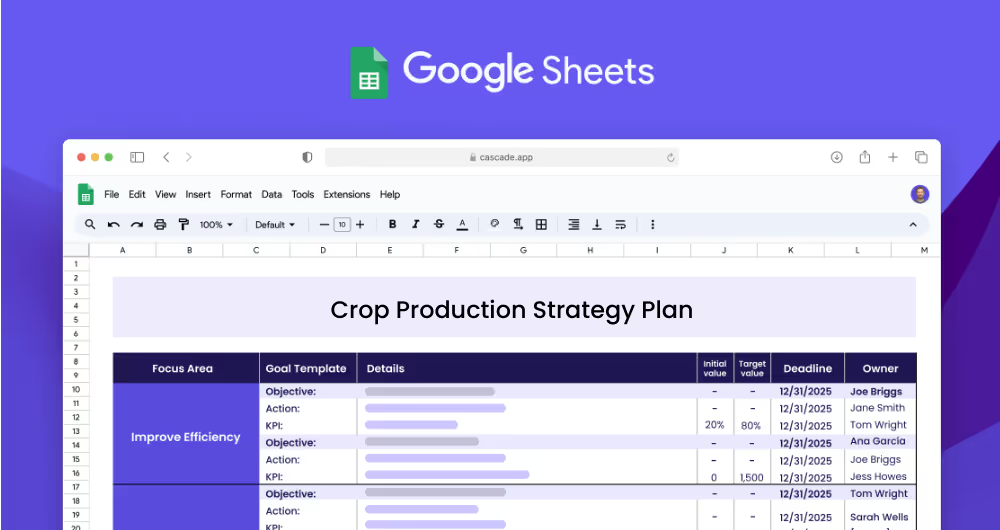A crop production strategy plan outlines the practical steps needed to meet the desired goals for crop production. It is a comprehensive plan that outlines the objectives, actions, and measurable targets (KPIs) necessary to achieve the desired outcome. It also serves as a roadmap for how to implement projects and make decisions throughout the crop production process.
Each focus area has its own objectives, projects, and KPIs to ensure that the strategy is comprehensive and effective.
The Crop Production Strategy Plan template is designed for agricultural companies, farming cooperatives, and other organizations involved in crop production and management who are looking to develop or improve their strategic plans. The template provides a comprehensive overview of the key components of a crop production strategy plan.
The first step in developing a crop production strategy plan is to define the focus areas. Focus areas are the broader goals and objectives that the plan should strive to achieve. Examples of strategic focus areas that could fall under a Crop Production Strategy Plan could be: Improve Crop Yield, Improve Water Management, and Reduce Pesticide Usage.
Once the focus areas have been identified, the next step is to think about the objectives that could fall under each focus area. Objectives are the specific goals that should be achieved in order to meet the broader focus area. Examples of objectives could include increasing crop yield, improving soil quality, increasing irrigation efficiency or reducing the use of pesticides.
Setting measurable targets (KPIs) is an important part of the crop production strategy plan. KPIs are measurable targets that can be used to track progress towards the objectives. Examples of KPIs could include increasing average crop yield from 10 tons/acre to 15 tons/acre, increasing average soil organic matter from 2.7% to 4.5%, increasing irrigation efficiency from 35% to 60%, or decreasing total water usage by 40%.
Once the KPIs have been established, the next step is to implement related projects to achieve them. Projects are the practical steps that must be taken in order to meet the KPIs. Examples of projects could include utilizing fertilizers to increase crop yield, using organic matter to improve soil quality, replacing traditional irrigation systems to increase irrigation efficiency, or implementing integrated pest management to reduce pesticide usage.
If you’re ready to take your strategy beyond spreadsheets and accelerate your results, Cascade Strategy Execution Software is an ideal upgrade. With Cascade, you gain access to a dynamic platform that enhances real-time updates, centralized collaboration, and automated reporting. This allows your team to easily track progress, adapt quickly to changes, and maintain alignment all at once. Sign-up for free or book a demo with one of our strategy experts today and start seeing the benefits of streamlined strategy execution.


